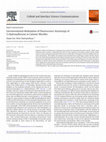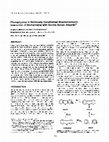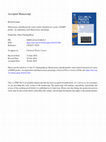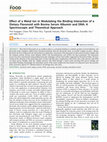Papers by Nitin Chattopadhyay
RSC Advances, Dec 31, 2022
The cis-skew → trans-planar photoisomerization of 1, 2-di(furan-2-yl)ethane-1, 2-dione (2, 2´-fur... more The cis-skew → trans-planar photoisomerization of 1, 2-di(furan-2-yl)ethane-1, 2-dione (2, 2´-furil), a 1,2-dicarbonyl compound, in the photoexcited triplet state has been investigated by photoacoustic calorimetry in a series of n-alkane solvents at room temperature. The photoisomerization process is associated with a structural volume change of the probe. This has been evaluated and compared with the theoretically calculated volumes of cis and trans geometries of furil. The study reveals that an expansion in volume occurs during the photoinduced isomerization process. In low polarity alkane solvents, electrostrictional contribution to the estimated volume change has been argued to be negligible.
ffect of environmental perturbations n the exicited state proton transfer (ESPT) reaction has bee... more ffect of environmental perturbations n the exicited state proton transfer (ESPT) reaction has been dilssed. The perturbation is provided by t e solvent or an external agent like crown ether, micelle-forming sur actant or cyclodextrin through chan s in polarity and viscosity of the medium or some specific int action with the probe. It has been obse ed that the perturbation has a marked effect on the equilibrium as ell as on the kinetic nites of ESPT. For a encapsulated molecule the prototropic reaction has been shown to epend on the micro-environment as ell as the molecular structure of the probe.
ChemistrySelect, Jul 21, 2017
Scheme 1. Schematic structure of 3-hydroxyflavone (3HF) in (A) water, (B) a-CD, (C) b-CD and (D) ... more Scheme 1. Schematic structure of 3-hydroxyflavone (3HF) in (A) water, (B) a-CD, (C) b-CD and (D) g-CD.

Colloid and Interface Science Communications, 2017
Atypical trend for the fluorescence anisotropy of an excited state intramolecular proton transfer... more Atypical trend for the fluorescence anisotropy of an excited state intramolecular proton transfer (ESIPT) prone molecular system, namely, 3-hydroxyflavone (3HF) has been reported in the aqueous cationic micellar media. Contrary to the conventional rising trend of fluorescence anisotropy for fluorophores with the addition of the micellar environments, 3HF exhibits a decreasing trend in the fluorescence anisotropy in cationic micelles. Disruption of the intermolecular hydrogen bond induced solvated structure involving 3HF and the water molecules is assigned to be responsible for this unusual modulation of the fluorescence anisotropy in the micellar microenvironments. As micelles mimic the bio-membranes, this unconventional behavior of the fluorescence anisotropy of 3HF is significant to understand the intricacies of solvation and thereby action of bioactive ESIPT prone flavonoid molecules in bio or biomimicking environments.

Photochemistry and Photobiology, Apr 30, 2007
Steady-state photophysics of norharmane (NHM), a bioactive alkaloid, has been studied in the pres... more Steady-state photophysics of norharmane (NHM), a bioactive alkaloid, has been studied in the presence of a model transport protein, bovine serum albumin (BSA). The emission spectrum undergoes a remarkable change upon addition of BSA to the aqueous solution of NHM in buffer. Addition of BSA leads to a marked increase in the fluorescence anisotropy of the neutral species of NHM, although the fluorescence anisotropy for the cationic species is almost invariant to BSA addition, suggesting that the neutral species is located in a motionally restricted environment of BSA, whereas the cationic species remains in the bulk aqueous phase. The binding constant (K) and free energy change (AG) for the probe-protein binding have been calculated from the fluorescence data. Light has been thrown on the action of urea on protein-bound NHM. The denaturation study suggests that the protein, in its native form, binds with NHM. Polarity of the microenvironment around the probe has been determined from a comparison of the fluorescence properties of the two prototropic species of NHM in water-dioxane mixture with varying composition.

Chemical Physics Letters, Sep 1, 2018
The present letter reports unusual high fluorescence anisotropy of excited state intramolecular p... more The present letter reports unusual high fluorescence anisotropy of excited state intramolecular proton transfer (ESIPT) prone 2-(2-hydroxyphenyl)benzoxazole (HBO) in water followed by its imidazole (HBI) and thiazole (HBT) analogues. The low fluorescence anisotropy of the acetate compound of HBO in water reveals the key role of the hydrogen bonded cage-like probe-water cluster for the findings in water. Formation of the aquated cluster is controlled possibly by the combined effect of the electronegativity and mesomeric effect of the heteroatom away from the ESIPT site. The work invites further explorations, preferably from computational perspective, for a proper explanation. KEYWORDS 2-(2-hydroxyphenyl)benzoxazole, ESIPT, Fluorescence anisotropy, Hydrogen bonding, Solvated structure. Highlights Fluorescence anisotropy of studied analogues in water follows the order HBO> HBI>HBT AHBO, devoid of hydroxyl proton, exhibits low anisotropy in the studied solvents Hydrogen bonded probe-water cluster formation is responsible for the high anisotropy Cluster formation is controlled by the heteroatom not involved in the ESIPT process

International Journal of Pharmaceutics, Jun 1, 2019
Medicine is a natural companion of mankind of the present era for mere survival from the deadly d... more Medicine is a natural companion of mankind of the present era for mere survival from the deadly diseases in the ever-increasing polluted environments. Hence, in recent years, major focus of pharmaceutical, medicinal and biophysical research has been navigated in exploring and developing new and simple avenues to enhance the efficacy of the administered drugs on one hand and to get rid of, or at least reduce, the toxic side effects of the excess drugs accumulated in human body on the other. A potential approach to amplify the efficacy of the administered drug is to develop proficient targeted drug delivery systems (DDSs). This review provides an essence of some newly developed simple but prospective strategies on enhancing the efficacy of drugs/bioactive molecules exploiting various drug delivery systems like micelles, cyclodextrins, liposomes etc. to serve the purpose of targeted delivery towards DNA, by endogenous and/or exogenous means. Improved bio-availability and solubilization of ionic drugs within the less polar target regions from the bulk aqueous phase has also been achieved through the introduction of some physiologically permissible salts. In the other context, in vitro and in vivo studies demonstrate a simple technique for easy removal of the excess adsorbed drug molecules from the cell membranes/lipid bilayers by exploiting health-amiable supramolecular assemblies. In this review, we summarize the recent experimental findings, mostly from our lab, encompassing the development of simple biocompatible methods to enhance the benevolent role of drugs through their safe, effective and convenient administration. It also presents easy and effective means to remove the excess adsorbed drugs from human body to diminish their malign effects. These prospective approaches of drug delivery and excretion of drug molecules have promising roles to play from both physicochemical and pharmaceutical perspectives, ensuring enhanced bioavailability of drugs as well as disposing of drug-induced adverse side effects.
Biophysical Chemistry, Dec 1, 2016
Binding interactions of PSF with TX-100 micelle and ctDNA have been investigated independently. •... more Binding interactions of PSF with TX-100 micelle and ctDNA have been investigated independently. • In the presence of DNA, transfer of PSF from the micellar environment to the DNA occurs. • Competitive binding is ascribed to be responsible for the relocation of the probe. • TX-100 micelle does not affect the structure of the ctDNA. • TX-100 micelle can be used as a safe carrier for the delivery of drugs to DNA.
Journal of Photochemistry and Photobiology A-chemistry, Feb 1, 2020
This is a PDF file of an article that has undergone enhancements after acceptance, such as the ad... more This is a PDF file of an article that has undergone enhancements after acceptance, such as the addition of a cover page and metadata, and formatting for readability, but it is not yet the definitive version of record. This version will undergo additional copyediting, typesetting and review before it is published in its final form, but we are providing this version to give early visibility of the article. Please note that, during the production process, errors may be discovered which could affect the content, and all legal disclaimers that apply to the journal pertain.
Statistical science and interdisciplinary research, Jun 12, 2012
Twisted intramolecular charge transfer (TICT) of p-N. N-dimethylaminobenzaldehyde (DMABA) has bee... more Twisted intramolecular charge transfer (TICT) of p-N. N-dimethylaminobenzaldehyde (DMABA) has been studied in different aqueous cyclodextrin (a-. (l-and r-) environments. The tluorophore forms 1:1 complexes with all the three cyclodextrins (CD). The TICT emission is extremely weak in pure water but it is enhanced as the probe is encapsulated within the cyclodextrin cavities. The relative enhancement of the emission from the TICT species to the locally excited (LE) species is maximum in the a-CD environment and minimum in the y-CD environment. This differential enhancement of the two emission bands in different aqueous CD solutions has been explained on the basis of the polarity factor. It has been suggested that the polarity of the microenvironment is the principal controlling factor for the TICT process.
Journal of Photochemistry and Photobiology A-chemistry, Feb 1, 2023

Journal of Physical Chemistry B, Dec 4, 2021
Steady-state and time-resolved spectroscopic studies demonstrate that two members of the coumarin... more Steady-state and time-resolved spectroscopic studies demonstrate that two members of the coumarin class of dyes, coumarin 7 (C7) and coumarin 30 (C30), undergo self-aggregation in water. The development of hypsochromically shifted new absorption bands in addition to the existing monomer bands with an increase in concentration of the dyes in an aqueous medium suggests that the aggregates are of H-type. An absorption-based kinetic study reveals that the rate of aggregation of C30 is an order of magnitude faster than that of C7. Second-order rate kinetics, as obtained from the half-life (t1/2) data, implies that the aggregates are dimeric in nature. Observations of isosbestic points in area-normalized absorption spectra (ANAS) and isoemissive points in area-normalized fluorescence excitation spectra (ANFES) and time-resolved area-normalized emission spectra (TRANES) establish that ground-state monomer ⇌ dimer equilibria for both of the systems are preserved in the photoexcited state. The present study further establishes that β-cyclodextrin is the most efficient of the three common cyclodextrins in shifting the equilibria toward the monomer by encapsulating the monomers within its cavity, making β-CD a convenient modulator to control the self-aggregation process. Dynamic light scattering (DLS), quantum chemical calculations, and molecular docking studies provide further support to our propositions.

Journal of Photochemistry and Photobiology A-chemistry, Jul 1, 2011
Excited state intramolecular proton transfer (ESIPT) of 2-hydroxy-1-naphthaldehyde semicarbazone ... more Excited state intramolecular proton transfer (ESIPT) of 2-hydroxy-1-naphthaldehyde semicarbazone (2HNS) has been studied in n-heptane and methanol solvents exploiting absorption, steady state and time-resolved fluorometric techniques. Experimental results reveal that although the intramolecular proton transfer (IPT) reaction does not take place in the ground state (S0), the process is feasible in the lowest excited singlet state (S1). Ab initio quantum chemical calculations have been carried out to judge the feasibility of the IPT process in the different electronic states. Density functional theory (DFT) has been used for the ground state calculations while those relevant to the lowest excited singlet state have been performed exploiting the time dependent density functional theory (TDDFT) using the B3LYP functional at 6-31G** level. The distances of the transferable hydrogen from the oxygen atom (wherefrom it is dislocated during the IPT reaction) as well as the nitrogen atom (to which it gets attached) have been taken as the independent reaction coordinates. The calculations reveal that either of these two parameters may be used to monitor the progress of the prototropic process since both lead to the same prototropic species passing through the same transition state. Simulation of the potential energy curves (PECs) and potential energy surfaces (PESs) leads to visualize the advancement of the reaction. Calculations imply that formation of the tautomer in the S0 state leads to endothermicity, while the process is exothermic in the S1 state. The calculated activation energy (Eact) of the process also decreases in the excited state. Thus, although the reaction is not feasible in the ground state, both the thermodynamic (ΔH) and the kinetic (Eact) factors favor the prototropic process to occur in the S1 state. This article reveals that any of the suitably and logically chosen structural parameters giving the same value of the reaction parameters and resulting in the same transition state may serve as the reaction co-ordinate.
Chemical Physics Letters - CHEM PHYS LETT, 2001
Indian journal of …, 2004
The photophysical behavior of pyrene-end-capped poly(ethylene oxide) (PYPY) has been studied in w... more The photophysical behavior of pyrene-end-capped poly(ethylene oxide) (PYPY) has been studied in water and aqueous α-, β-and γ-cyclodextrin (CD) environments through steady-state and time-resolved spectroscopy. Both absorption and fluorometric studies reveal that α-, β- ...

ACS Food Science & Technology, 2022
Plant-derived flavonoids are an excellent option as a potential substitute to synthetic products ... more Plant-derived flavonoids are an excellent option as a potential substitute to synthetic products in food industries, and flavonoid−metal complexes exhibit better functional properties than free flavonoids. Here, an iron(II) complex of rutin, a dietary flavonoid, has been synthesized and characterized. A comparative assessment of the interaction of rutin and its iron(II) complex with the transport protein [bovine serum albumin (BSA)] and deoxyribonucleic acid (DNA) has been performed. The interaction process has been characterized using multispectroscopic techniques and has been further supported by theoretical studies. We have evidenced the alteration in the interacting mode of rutin with BSA upon complexation with Fe(II). Also, rutin interacts with DNA via minor groove binding, while the complex interacts with DNA through a mixed mode involving both groove binding and intercalative binding. Interestingly, the antioxidant activity of the metal complex has been found to be enhanced, and it also provides better protection against UV radiation-induced cell damage than rutin alone.
917-919Results of some preliminary steady state, time-resolved and theoretical studies on the pho... more 917-919Results of some preliminary steady state, time-resolved and theoretical studies on the photo physics of 2.3-dihydro-2,2,4 -trimethyl-1H-1,5-benzodiazepine (L), an anti-convulsant agent, are reported here, Although L is weakly fluorescing in all the solvents studied, its luminescence is highly solvent-sensitive. It seems that the protic solvents have an important role in the fluorescence behaviour of L. Participation of the methylene hydrogens in the solvent assisted proton transfer has been proposed
Uploads
Papers by Nitin Chattopadhyay